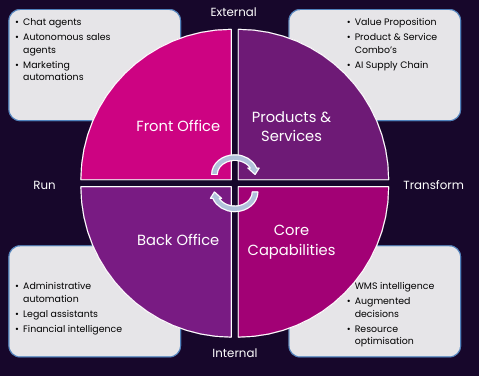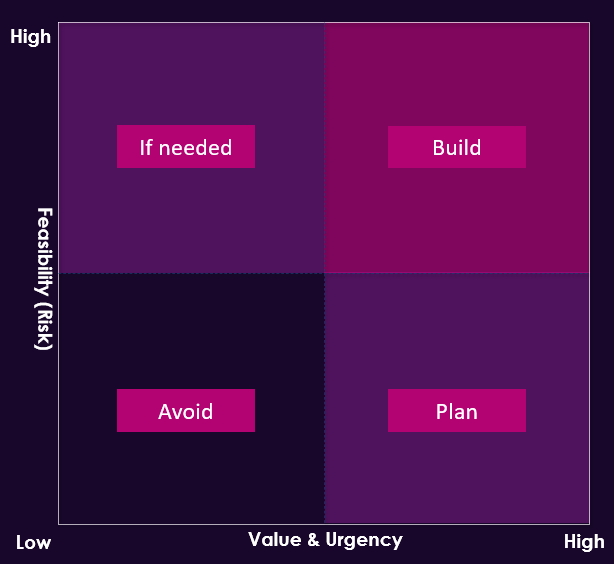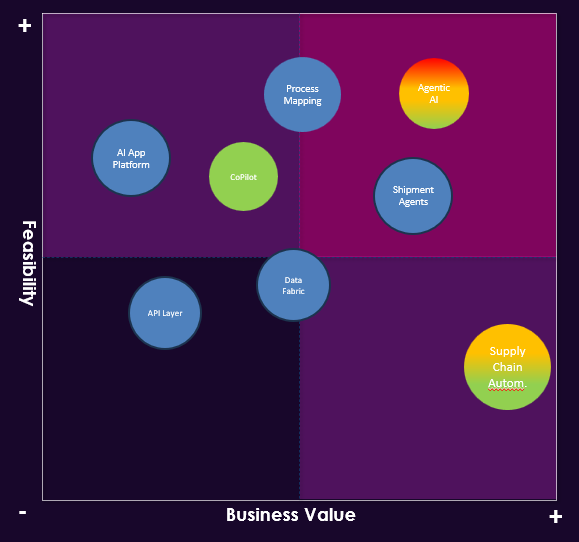How Curiosity Leads to HAL
In recent months, we have seen a substantial increase in companies asking for support to develop an AI adoption roadmap. They share the same challenge: whilst AI has many capabilities, they struggle to find a logical and structured way to adopt it in their organisation.
Overview
This blog outlines one way organisations can tackle this question, taking into account aspects such as the readiness of technology, the overall maturity of the organisation and with an emphasis on driving immediate results from projects. In this how-to-guide you will learn:
Which challenges you will face to create a roadmap
How to determine Business Value
Selecting use cases for AI Adoption
Mapping potential pilots on a heat map
Turninga heat map into a roadmap
THE AI ADOPTION CHALLENGE
As the dust of ChatGPT's and the wider GenAI models are settling, organisations are now starting to consider how they can adopt AI within their organisation. Gartner's research directly points to three major barriers to adoption, each of which an organisation needs to consider for their specific use cases. Let's review these three challenges in more detail.1. Business Value
Early adopters of AI report mixed results from their projects. Gartner predicts that 30% of AI pilot projects will be closed down by the end of 2025, either through lack of business value, results or excessive costs. In other words, pilot projects are started without a clear picture about what those pilots are going to contribute to the organisation's wider strategic objectives. That in turn makes it impossible to determine correct cost levels and pay off.2. Technology Maturity
What does that mean for organisations looking to adopt AI in the enterprise? Immature technologies have two inherent risks:
Risk: Capabilities
Immature technologies may lack the capabilities to produce the results organisations are looking for, leading to lower quality, higher projects costs, etc.
Risk: Obsolence
Immature technologies may be superseded by others and never reach maturity. Any investments and developments made in a technology that is obsolete before maturity will not materialise in long term outcomes.
3. Organisational Readiness
Factor: Expertise
Organisations often lack the internal knowledge and expertise to make the most of AI. This applies to both IT's ability to deliver the right solutions and the organisation's ability to use technology effectively.
Factor: Integration
Many organisations have an existing technology landscape, which is not always ready for AI adoption. Challenges exist around integration, the effective use of high quality data, and keeping IT secure and compliant with local regulations.
PROGRESSION STRATEGY
Step 1: Define Business Value
Revenue
Maintaining or increasing the overall sales volume by selling more, either of existing product/services or introducing new ones.
Market Share
Out competing your direct competitors and gaining more customers in the same markets.
Profitability
Boosting or maintaining the organisation's earnings by driving operational excellence in all processes.
Compliance
Ensuring your organisations stays compliant with the relevant legislation and frameworks.
Step 2: Identify AI Use Cases
Why Use Cases Are The Right Approach
For AI adoption, taking an agile approach is generally a better fit due to its adaptability and iterative nature. AI projects often involve experimentation, evolving requirements, and the need for frequent testing and refinement based on real-world data. Agile's ability to incorporate continuous feedback and adjust priorities aligns well with the dynamic nature of AI development, reducing risks and ensuring faster delivery of functional solutions.
As a natural extension of adopting an agile approach to AI adoption, use cases form an excellent way to start work, yet stay flexible to adopt new capabilities and evolving needs.
How To Select Use Cases
Great use cases are a direct extension of the corporate objectives, ensuring seamless alignment between AI investments and the outcomes organisations are looking to achieve. We apply categorisation of use cases across various dimensions, helping us further prioritise use cases:
- To which corporate objective they will contribute.
- Whether this is s customer facing or internal solution.
- If a use case will optimise existing processes (run) or create a major leap forward (transform).

Mapping use cases across dimensions
Once organisations have created their long list, they will be able to start prioritising high potential use cases. Generally we advise organisations to follow an 80/20 split between use cases that run the business versus transforming. The latter is often more complex and experimental, only yielding results longer term.
For shortlisted use cases organisations should capture:
- The business value of a use case expressed in quantified contribution to corporate objectives.
- The business area targeted and underlying processes that will be impacted.
- The complexity of the use case expressed in 'running processes' or 'transforming processes'.
- The identified risks of implementing the specific use case.
- The feasibility of the use case expressed in tech maturity and organisational readiness.
The risk at this stage is for organisations to get stuck in details. Keep the use case identification step pragmatic, use common sense and get to a version 0.7 of your shortlist.
Step 3: Use Case Mapping
Feasibility
This reflects how easy it is to implement the use case, taking into account technology maturity, organisational readiness, the current tech landscape capabilities and potential risks.
Value
This reflects the contribution to corporate objectives.

The ideal way to complete this diagram is in a workshop, with all relevant parties present. This will support ongoing discussions about use case prioritisation and drive consensus around decision making. Whilst it is good to carefully consider the positioning of use cases on the map, keep things pragmatic and apply common sense.
Step 4: Completing the Heat Map

Mapping the prerequisite technologies will give organisations an accurate reflection of the feasibility of use cases and work involved in making them reality, plus opening up the path to creating a unified roadmap of technologies that underpin all AI initiatives.
In our example, for a supply chain company, the team has identified driving automations in their supply chain as a prime objective to deliver higher profitability and growth. They want to create shipment agents which autonomously execute tasks in their processes, which in turn requires centralised data, application integration and an AI platform that facilitates development.
Step 5: Turning the Heatmap into a Roadmap
- The order in which prerequisite technologies need to be deployed to achieve a use case.
- Which steps may be executed in parallel, such as foundational technology deployments and process optimisations.
- Tackling highly feasible steps before proceeding with more complex initiatives.

In our example, the business aims to achieve extensive automation in their supply chain. They require autonomous AI agents to perform certain shipment steps, which in turn rely on a variety of technologies and an evaluation of their current processes. Once the initiatives are linked, this gives us two parallel workstreams leading up to their overarching goals:
Process Optimisation
They can start evaluating the processes they are targeting for automation to identify where they can achieve immediate efficiency gains using AI agents.
Technology Stack
They can start deploying the required technology stack by creating an AI development platform that links to their existing app landscape through APIs and centralising data in a Data Fabric environment.
Once they have completed those steps, they will have a clear view of which agents they need to build and what those agents will do, plus a platform ready to develop and deploy those solutions individually. Crucially, in this example, the business first tackles the more feasible (lower risk) steps before starting the more complex task of developing and deploying agents.
Whilst this visual approach is best for workshops and communicating priorities to teams, it is a relatively easy step to convert this into a project plan or strategic roadmap.

Organisations should use this simple overview and augment it with clear dates and deadlines, plus an analysis of the required resources and potentially external support needed for successful execution.
CONCLUSION: HOW FEASIBILITY AND VALUE DRIVEN AI SUCCESS
The approach we outline here takes into account the most crucial elements for successful AI adoption, taking into account all elements organisations need to consider when they are starting their AI journey:Business Value
Start with measurable strategic objectives to ensure AI initiatives will contribute to overarching organisational goals, delivering a clear way of assessing return on investment.
Feasibility
Consider your organisational readiness to adopt AI in business areas and the maturity of technologies required to deliver use cases, ensuring successful outcomes of projects.
Phased & Modular
Taking a thoughtful and phased approach to deliver AI modules that are fit for purpose, whilst remaining agile and deliver AI adoption in small iterations, allowing your organisation to grow expertise before tackling more complex issues.
At Gartner's 2024 Symposium, the company projects that 30% of AI Pilots are destined to terminate prematurely, due to excessive costs, complexity or lack of business value. The approach outlined in this blog directly targets each of those high risk areas, resulting in higher pilot and project success rates and value contribution.
HOW GYSHO SUPPORTS AI ADOPTION
The AI Adoption Roadmap outlined in this blog is a direct result of our collaboration with customers. We have conducted workshops for various organisations across different industries. The creation of this roadmap is a crucial component of Gysho's Artificial Intelligence-as-a-Service offering. This package bundles everything your organisation needs for AI adoption into a single monthly flat fee subscription:
AI Advisory
We provide a range of services to support adoption planning and enhance your current team's expertise. This includes workshops that implement the strategies discussed in this blog, technology selection and maturity assessments, and more.
Development
Our development team constructs AI solutions using a modular AI stack that integrates seamlessly with your existing technology infrastructure, adding enhanced capabilities to your organisation.
Maintenance & Support
Gysho maintains and optimises AI platforms and assists your teams in effectively utilising AI tools.
Flexible Pricing Tiers
Our AI-as-a-Service offering is available in three service levels, each tailored to your organisation's AI maturity and size.
Let's Get Started
Contact our team for a free consultation, where we will assess the current state of AI in your organisation and provide guidance on how to get started. If you're short on time, we can also conduct a workshop to help create your AI Roadmap.
Tags:





